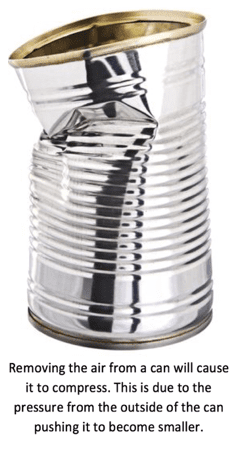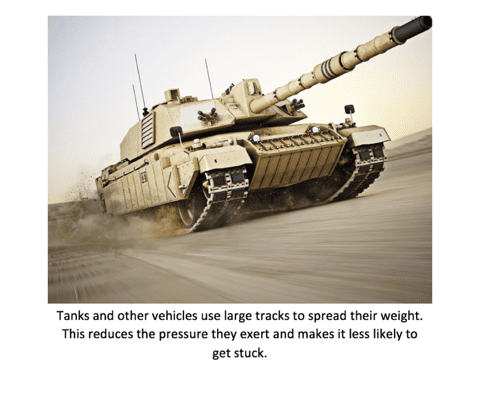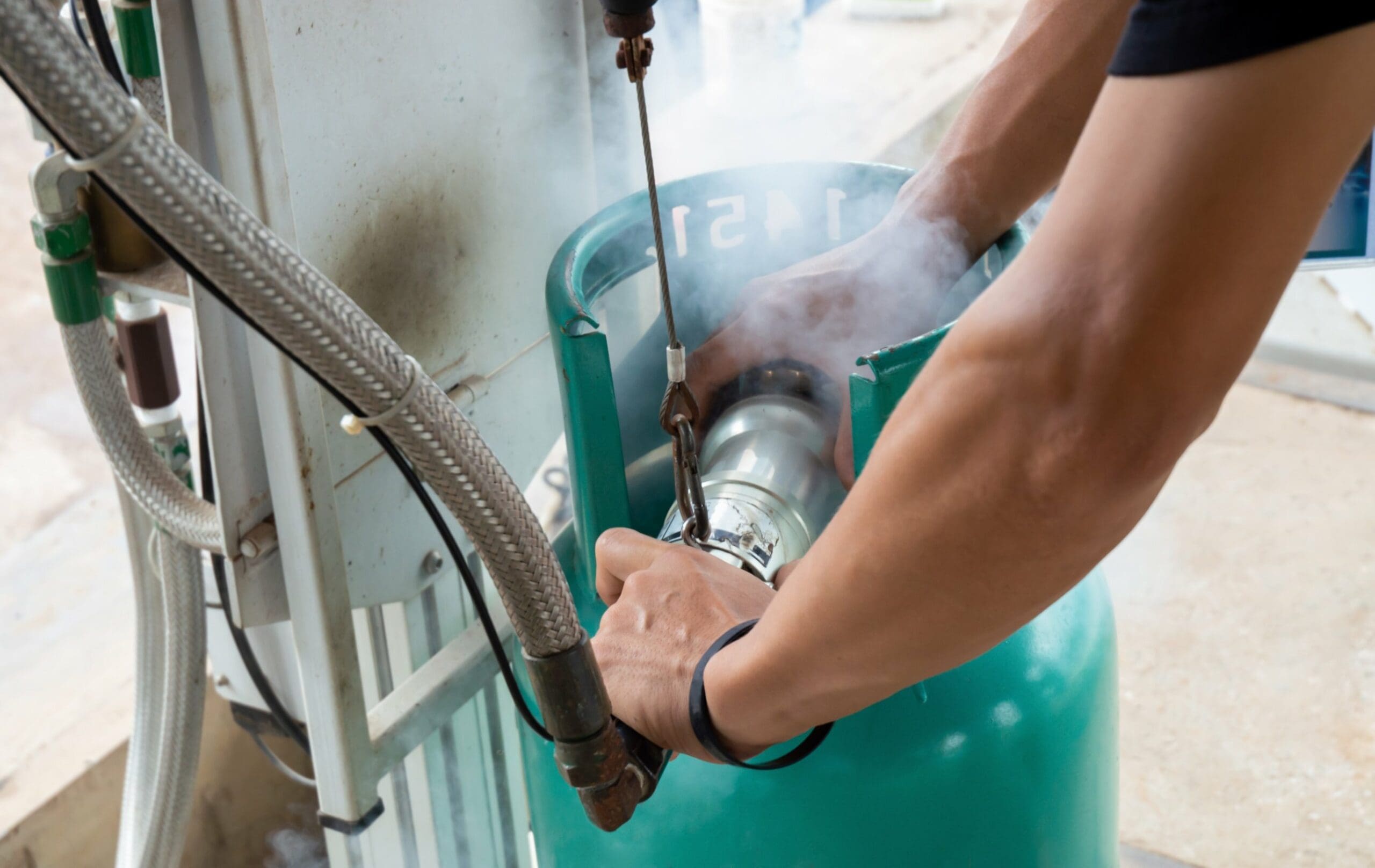In this post
The effects of changes in pressure can be observed in the behaviour of liquids and gases. The pressure exerted at any point from a gas or liquid at rest, is affected by a number of factors but always acts equally in all directions. This means that, if something is submerged in water, the water pushes on the objects from all angles equally. This can be observed if you take a can of water and pierce holes along the bottom. As long as all of the holes are placed at the same depth, when the can is filled with water, the water is forced out with equal strength all the way along the bottom of the can.

Gases and liquids are not only put under pressure but also exert pressure on to other things around them. For example, the air in the atmosphere is very Sdense and therefore applies a pressure on to our bodies of around 100,000 Pa. However, our bodies exert a similar pressure outward because we have liquids and gases in our body.
The effects of pressure can be demonstrated using a tin can. If the air is removed from inside the can, a vacuum is created. The pressure outside of the can is now greater than the pressure inside the can. As a result, the can is compressed inwards as shown in the diagram on the right.
Pressure and depth
In liquids, there is a change in pressure depending upon the depth. As the depth of the fluid increases, the pressure increases. For example, there is very little pressure in the water at the surface of a lake. However, if you dive down to a depth of 20 metres below the surface, the pressure increases. Eventually the pressure at deeper depths becomes so great that you are physically unable to swim there without being crushed.
This difference in pressure occurs because the fluid that is deeper down has the added pressure from the force of weight of the fluid above it. The deeper the fluid is, the more combined weight there is above it and this increase in force causes an increase in pressure.
Pressure in gases and liquids is measured relative to normal air pressure. The difference between the pressure exerted by the gas or liquid and normal air pressure is known as the pressure difference.
The pressure difference can be measured using a piece of equipment known as a manometer which has two straight columns joined by a curve at the bottom to form a U-shaped tube.
The two straight columns contain liquid but there is a difference in the pressure exerted on the liquid in each column. This difference in pressure causes the liquid to be at different heights in each of the columns.
The pressure of the liquid in both columns can be calculated as long as the density of the fluid, the height of the fluid and the gravitational field strength are known.
Calculating pressure difference
Force is calculated by multiplying the mass of the fluid by the gravitational field strength () which, on Earth, is 10 N/kg. The mass of fluid in the container is calculated using the equation:
![Rendered by QuickLaTeX.com \[ \text{mass of water} = A \times h \times \rho \]](https://b3801007.smushcdn.com/3801007/wp-content/ql-cache/quicklatex.com-6b6119b58792fe3e8a38a58727fe25fe_l3.png?lossy=2&strip=1&webp=1)
where A = area of the base of the container (measured in m2),
h = height of the container (measured in metres)
ρ = density of the liquid
Therefore, the equation used to calculate the force can be rewritten as:
![Rendered by QuickLaTeX.com \[ \text{F} = (A \times h \times \rho) \times g \]](https://b3801007.smushcdn.com/3801007/wp-content/ql-cache/quicklatex.com-d1e009d2bbc9ced4b9756f8b86825dc1_l3.png?lossy=2&strip=1&webp=1)
To calculate the pressure, we use the equation:
![Rendered by QuickLaTeX.com \[ \text{Pressure} = \frac{\text{Force}}{\text{Area}} \]](https://b3801007.smushcdn.com/3801007/wp-content/ql-cache/quicklatex.com-54775bd9a03807d3cdcc2da0b9ccbb4a_l3.png?lossy=2&strip=1&webp=1)
If force is calculated using the equation:
![Rendered by QuickLaTeX.com \[ \text{F} = (A \times h \times \rho) \times g \]](https://b3801007.smushcdn.com/3801007/wp-content/ql-cache/quicklatex.com-d1e009d2bbc9ced4b9756f8b86825dc1_l3.png?lossy=2&strip=1&webp=1)
the overall equation used to calculate pressure can be written as:
![Rendered by QuickLaTeX.com \[ \text{Pressure} = \frac{A \times h \times \rho \times g}{\text{A}} \]](https://b3801007.smushcdn.com/3801007/wp-content/ql-cache/quicklatex.com-c372b46a7afcaca6d673ee83b7877560_l3.png?lossy=2&strip=1&webp=1)
Here we can see that we have , which is the area on the bottom and the top of the fraction, so they cancel each other out. This means that the area of the water does not matter when calculating pressure.
By cancelling out the area the equation to calculate pressure difference becomes:
![Rendered by QuickLaTeX.com \[ \text{Pressure difference} = \text{height} \times \text{density} \times \text{gravitational field strength}\]](https://b3801007.smushcdn.com/3801007/wp-content/ql-cache/quicklatex.com-4977e3dc967efd165ccaeec2c2cc8522_l3.png?lossy=2&strip=1&webp=1)
![Rendered by QuickLaTeX.com \[ p = h \times \rho \times g\]](https://b3801007.smushcdn.com/3801007/wp-content/ql-cache/quicklatex.com-62373b86bf4f633d24a9a410fdfcd053_l3.png?lossy=2&strip=1&webp=1)
Pressure difference is measured in pascal (Pa)
Height is measured in metres (m)
Density is measured in kilograms per metre cubed (kg/m3)
Gravitational field strength is measured in Newtons per kg (N/kg)
You must know and be able to use this equation as it will not be provided in the exam.
Example
A large tank on Earth contains water with a density of 1,000 .
Calculate the pressure difference for the water at a depth of 5 m.
The depth provided in the question is the same as the height. The density has also been provided in the question and although the gravitational field strength is not given, we know that the water is on Earth so the gravitational field strength is 10. We can then substitute these values into the equation to calculate pressure difference:
![Rendered by QuickLaTeX.com \[ p = h \times \rho \times g\]](https://b3801007.smushcdn.com/3801007/wp-content/ql-cache/quicklatex.com-62373b86bf4f633d24a9a410fdfcd053_l3.png?lossy=2&strip=1&webp=1)
![Rendered by QuickLaTeX.com \[ p = 5m \times 1000 \frac{kg}{m^3} \times 10 N/kg\]](https://b3801007.smushcdn.com/3801007/wp-content/ql-cache/quicklatex.com-d6eeb0da52f33794f5c6bed33f3f68db_l3.png?lossy=2&strip=1&webp=1)
![Rendered by QuickLaTeX.com \[ p = 50,000Pa\]](https://b3801007.smushcdn.com/3801007/wp-content/ql-cache/quicklatex.com-85bc0d12bf01a0eb5762f2bb477d5885_l3.png?lossy=2&strip=1&webp=1)
Using pressure
Pressure is used in many different situations, and once the laws of pressure are understood, they can be used to our advantage. Having something small that exerts a high pressure can make it easier to pierce objects – an example of this is a drawing pin. Drawing pins have a large round end for you to push. The round end has a large area, so it applies a low pressure to your thumb. The sharp end has a very small area. The same pushing force produces a high pressure on the sharp end, so the pin can be pushed into the noticeboard.
Alternatively, a large area which creates less pressure can also be useful. Camels, for example, have very wide feet so their body weight is spread over a larger area. This means they exert less pressure on sand so that they will not sink easily if they are travelling over soft ground.
Another example showing how important it is to consider pressure and area is vehicle design. Large vehicles with very large masses such as tanks or cranes, often use caterpillar tracks rather than wheels. This means the weight of the vehicle is spread over a larger area so less pressure is exerted at each specific point. This means the vehicle is less likely to sink when it is being used off-road.




